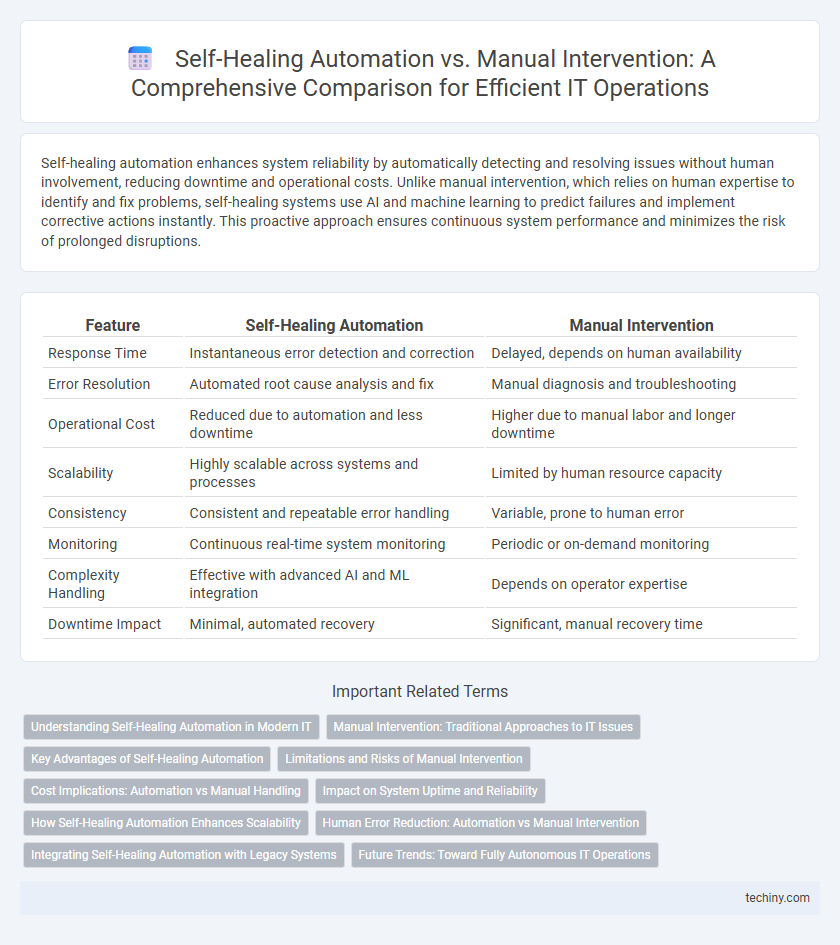Self-healing automation enhances system reliability by automatically detecting and resolving issues without human involvement, reducing downtime and operational costs. Unlike manual intervention, which relies on human expertise to identify and fix problems, self-healing systems use AI and machine learning to predict failures and implement corrective actions instantly. This proactive approach ensures continuous system performance and minimizes the risk of prolonged disruptions.
Table of Comparison
| Feature | Self-Healing Automation | Manual Intervention |
|---|---|---|
| Response Time | Instantaneous error detection and correction | Delayed, depends on human availability |
| Error Resolution | Automated root cause analysis and fix | Manual diagnosis and troubleshooting |
| Operational Cost | Reduced due to automation and less downtime | Higher due to manual labor and longer downtime |
| Scalability | Highly scalable across systems and processes | Limited by human resource capacity |
| Consistency | Consistent and repeatable error handling | Variable, prone to human error |
| Monitoring | Continuous real-time system monitoring | Periodic or on-demand monitoring |
| Complexity Handling | Effective with advanced AI and ML integration | Depends on operator expertise |
| Downtime Impact | Minimal, automated recovery | Significant, manual recovery time |
Understanding Self-Healing Automation in Modern IT
Self-healing automation in modern IT uses artificial intelligence and machine learning algorithms to automatically detect, diagnose, and resolve system issues without human intervention, significantly reducing downtime and operational costs. This technology continuously monitors infrastructure and applications, enabling proactive identification of anomalies and triggering corrective actions instantly. Unlike manual intervention, which relies on reactive troubleshooting, self-healing automation enhances system resilience and improves IT service continuity through automated problem resolution.
Manual Intervention: Traditional Approaches to IT Issues
Manual intervention in traditional IT issue resolution relies heavily on human expertise to diagnose and fix problems, often resulting in slower response times and increased risk of human error. This approach typically involves repetitive tasks such as system reboots, patch installations, and configuration adjustments performed by IT staff, leading to higher operational costs and reduced efficiency. Despite its limitations, manual intervention remains necessary for complex issues that automated systems cannot yet accurately address.
Key Advantages of Self-Healing Automation
Self-healing automation significantly reduces downtime by automatically detecting and resolving system anomalies without human input, enhancing operational efficiency and system reliability. It leverages AI and machine learning algorithms to predict potential failures and implement corrective actions proactively, minimizing the risk of costly disruptions. This approach improves scalability and consistency in IT environments compared to manual intervention, which is prone to delays and human error.
Limitations and Risks of Manual Intervention
Manual intervention in automation processes introduces significant limitations and risks, including increased downtime and human error that can compromise system reliability. Dependency on manual fixes slows response times, leading to prolonged outages and reduced operational efficiency. Furthermore, inconsistent human decision-making may result in security vulnerabilities and increased maintenance costs.
Cost Implications: Automation vs Manual Handling
Self-healing automation minimizes downtime and reduces operational costs by automatically detecting and resolving system faults without human intervention. Manual handling incurs higher labor expenses and longer resolution times, leading to increased operational inefficiencies and potential revenue loss. Investing in self-healing systems significantly lowers total cost of ownership by decreasing maintenance efforts and preventing costly system failures.
Impact on System Uptime and Reliability
Self-healing automation significantly enhances system uptime and reliability by autonomously detecting and resolving issues without human intervention, reducing downtime and minimizing errors caused by delayed responses. Manual intervention often leads to longer recovery times and increased risk of human error, which can compromise system stability and operational efficiency. Implementing self-healing systems ensures continuous monitoring and immediate corrective actions, ultimately maximizing productivity and minimizing service interruptions.
How Self-Healing Automation Enhances Scalability
Self-healing automation significantly enhances scalability by enabling systems to detect, diagnose, and resolve issues automatically without human intervention, reducing downtime and operational bottlenecks. This autonomous problem-solving capability allows for seamless adaptation to increasing workloads and complex environments, optimizing resource utilization. Unlike manual intervention, which is time-consuming and error-prone, self-healing mechanisms provide consistent and rapid recovery, supporting large-scale and dynamic infrastructure growth.
Human Error Reduction: Automation vs Manual Intervention
Self-Healing Automation significantly reduces human error by proactively identifying and resolving issues without manual input, enhancing system reliability and reducing downtime. Manual intervention relies heavily on human judgment, increasing the risk of mistakes and inconsistent responses during critical failures. Implementing self-healing processes ensures continuous operation with minimal disruptions, improving overall efficiency and accuracy in IT environments.
Integrating Self-Healing Automation with Legacy Systems
Integrating self-healing automation with legacy systems enables real-time issue detection and resolution without human intervention, reducing downtime and operational costs. Advanced AI-driven algorithms analyze system anomalies, automatically executing corrective actions while maintaining compatibility with existing infrastructures. This integration enhances system resilience and efficiency, bridging the gap between modern automation capabilities and traditional IT environments.
Future Trends: Toward Fully Autonomous IT Operations
Self-healing automation leverages AI-driven analytics and machine learning to detect and resolve IT issues without human input, significantly reducing downtime and operational costs. Future trends in this field emphasize the integration of advanced predictive models and real-time data processing to enable fully autonomous IT operations that adapt dynamically to evolving system environments. This shift toward autonomous infrastructure management aims to enhance system reliability, accelerate incident response, and optimize resource allocation seamlessly.
Self-Healing Automation vs Manual Intervention Infographic

 techiny.com
techiny.com